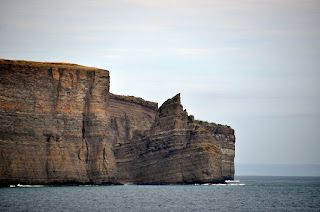When the mines shut down operations in 1966, a huge local economy was lost. While we will share only a few things in this blog, I found a video, a bit long, but I think it contains a lot of good content and great old footage. If you have the time and the interest, please watch.
History of Bell Island
Our tour through Mine # 2 was very enlightening, most especially because our tour guide had his grandfathers and great grandfathers working in the mines over the years (one who today at 94 is still alive). We got to tour almost 700 feet down into the Main Slope of mine #2 and also a couple of her spurs. There is a lot of information out there on the internet, and like I mentioned earlier the video link above is good. But, our guide telling us stories from his grandfather that is still living, well, it was really somewhat special. Our guide, and his grandparents and great grandparents have spent their entire lives on Bell Island.
The mine was set up with 6 main slopes. The main slopes had steam engine cars that ran continuous in the dark of the mines. Workers in the early days only had candle light to guide them, later not much more. The tunnels on the main slopes were 2 miles long, under the ocean floor and eventually covered 70 square miles. Off of the main slopes were various levels, with odd numbers on one side and even numbers on the other. The various level tunnels connected to the various 6 main slopes. Steam engines pulled rail cars filled with ore from the main slopes to daylight, while horses pulled the ore to the main slopes along the various spurs. Horses were stabled underground for 30 days at a time with shifts for both horses and men being 10 hrs/day, six days/week. At first when they brought the horses up out of the mines, they realized that after being underground for so long, they quickly went blind when exposed to daylight. Eventually they realized that by putting 5 layers of blinds on the horses, and removing one blind per day, that the horses would retain their eyesight. Once above ground, the horses were given 30 days of rest before being returned underground to the stables for another 30 days. Oh, and while the mines were in operations, there was also the ongoing job of continuously pumping water out of these mines.
Boys began working in the mines in the early years as early as age 11. At 11 they would sort the ore above ground and at 13 they would go underground with the men. It was dangerous work, mainly because one could not see. The greatest hazard was being killed by the rail cars going up and down the main slopes (the cars could not be seen or heard due to the darkness and noise). In the early years the men would paint white crosses at locations where men had died. When it was realized that the young miners, like 13, were afraid to go near the crosses, management ordered that the crosses be painted over. Of further note, small Bell Island was the only place in North America to take a direct hit from a Nazi U-Boat during WWII. This occurred when the Saganaga was sunk in 1942.
The people of the island were poorly educated, but hard working and when the mining came to an end, in their remote location, it became very hard times for them. The interview on the video link above states that the ferry ride to the nearest unemployment office in St. John's at that time cost $7. Well, in 2016 dollars that would be $56. While many left the island, there are some that have managed to stay, throughout their hard times.
Newfoundland Trivia: Throughout Canada, July 1 is celebrated as Canada day (when Canada became its own country). In Newfoundland, however, July 1 is also Remembrance Day. It is the day that 90% of the Newfoundland Regiment was wiped out in WWI at the Battle of Beaumont-Hamel. Unlike the rest of Canada, in Newfoundland on July 1, the flags are all hung at half mast until noon, prior to their celebration of Canada Day.








No comments:
Post a Comment